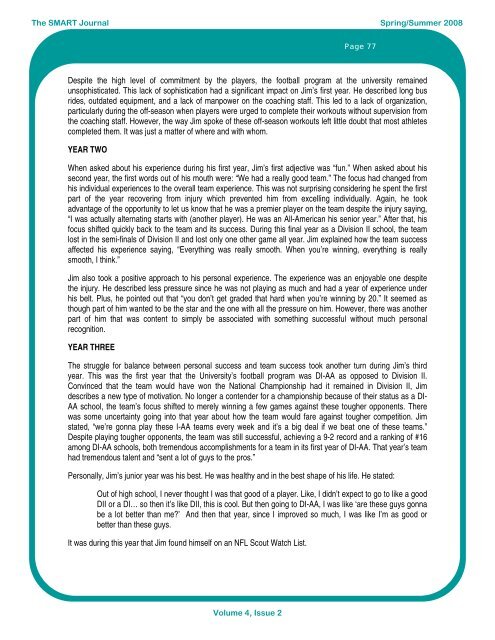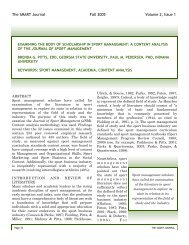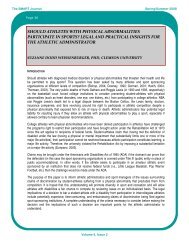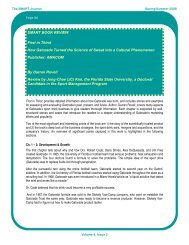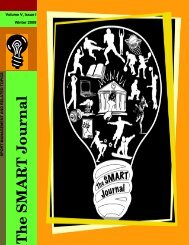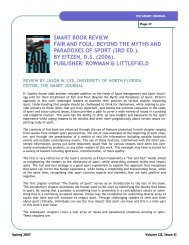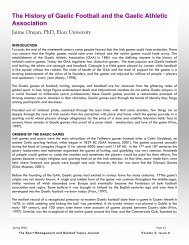Spring/Summer 2008 Volume 4, Issue 2 - The SMART Journal
Spring/Summer 2008 Volume 4, Issue 2 - The SMART Journal
Spring/Summer 2008 Volume 4, Issue 2 - The SMART Journal
Create successful ePaper yourself
Turn your PDF publications into a flip-book with our unique Google optimized e-Paper software.
<strong>The</strong> <strong>SMART</strong> <strong>Journal</strong> <strong>Spring</strong>/<strong>Summer</strong> <strong>2008</strong><br />
Page 77<br />
Despite the high level of commitment by the players, the football program at the university remained<br />
unsophisticated. This lack of sophistication had a significant impact on Jim’s first year. He described long bus<br />
rides, outdated equipment, and a lack of manpower on the coaching staff. This led to a lack of organization,<br />
particularly during the off-season when players were urged to complete their workouts without supervision from<br />
the coaching staff. However, the way Jim spoke of these off-season workouts left little doubt that most athletes<br />
completed them. It was just a matter of where and with whom.<br />
YEAR TWO<br />
When asked about his experience during his first year, Jim’s first adjective was “fun.” When asked about his<br />
second year, the first words out of his mouth were: “We had a really good team.” <strong>The</strong> focus had changed from<br />
his individual experiences to the overall team experience. This was not surprising considering he spent the first<br />
part of the year recovering from injury which prevented him from excelling individually. Again, he took<br />
advantage of the opportunity to let us know that he was a premier player on the team despite the injury saying,<br />
“I was actually alternating starts with (another player). He was an All-American his senior year.” After that, his<br />
focus shifted quickly back to the team and its success. During this final year as a Division II school, the team<br />
lost in the semi-finals of Division II and lost only one other game all year. Jim explained how the team success<br />
affected his experience saying, “Everything was really smooth. When you’re winning, everything is really<br />
smooth, I think.”<br />
Jim also took a positive approach to his personal experience. <strong>The</strong> experience was an enjoyable one despite<br />
the injury. He described less pressure since he was not playing as much and had a year of experience under<br />
his belt. Plus, he pointed out that “you don’t get graded that hard when you’re winning by 20.” It seemed as<br />
though part of him wanted to be the star and the one with all the pressure on him. However, there was another<br />
part of him that was content to simply be associated with something successful without much personal<br />
recognition.<br />
YEAR THREE<br />
<strong>The</strong> struggle for balance between personal success and team success took another turn during Jim’s third<br />
year. This was the first year that the University’s football program was DI-AA as opposed to Division II.<br />
Convinced that the team would have won the National Championship had it remained in Division II, Jim<br />
describes a new type of motivation. No longer a contender for a championship because of their status as a DI-<br />
AA school, the team’s focus shifted to merely winning a few games against these tougher opponents. <strong>The</strong>re<br />
was some uncertainty going into that year about how the team would fare against tougher competition. Jim<br />
stated, “we’re gonna play these I-AA teams every week and it’s a big deal if we beat one of these teams.”<br />
Despite playing tougher opponents, the team was still successful, achieving a 9-2 record and a ranking of #16<br />
among DI-AA schools, both tremendous accomplishments for a team in its first year of DI-AA. That year’s team<br />
had tremendous talent and “sent a lot of guys to the pros.”<br />
Personally, Jim’s junior year was his best. He was healthy and in the best shape of his life. He stated:<br />
Out of high school, I never thought I was that good of a player. Like, I didn’t expect to go to like a good<br />
DII or a DI… so then it’s like DII, this is cool. But then going to DI-AA, I was like ‘are these guys gonna<br />
be a lot better than me?’ And then that year, since I improved so much, I was like I’m as good or<br />
better than these guys.<br />
It was during this year that Jim found himself on an NFL Scout Watch List.<br />
<strong>Volume</strong> 4, <strong>Issue</strong> 2


